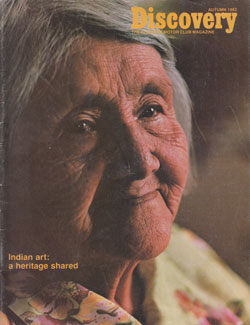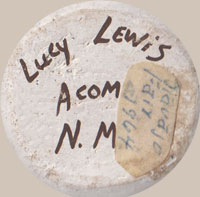Acoma Black-on-white Fine Line Design Jar [SOLD]
+ Add to my watchlist Forward to Friend
- Category: Modern
- Origin: Acoma Pueblo, Haak’u
- Medium: clay, pigment
- Size: 3-1/2” height x 4-1/2” diameter
- Item # C3736B SOLD
Lucy Lewis was a potter whose name most collectors recognize because she was at the forefront of potters following World War II when pueblo pottery began to be collected in earnest. One of her best-known designs was this complicated fine line style where the lines crossed in every direction. One must remember that these were painted using a brush fashioned from the leaf of a yucca plant. That certainly added to the complexity and is the reason not too many Acoma potters ever achieved the level to paint such a design.
A collector sees the finished product of a potter but may not know the intense work that goes into making a vessel before it reaches the finished stage. The first step is collecting clay from the family or pueblo clay beds, which remain secret from outsiders. The clay is impregnated with impurities which must be sifted out using a fine mesh wire sifter. Impurities in the clay will burn out during the firing and leave pits in the walls if not properly sifted out.

Clay is soaked for days or weeks before production of pottery. To strengthen a vessel, a tempering agent must be added to the clay. At Acoma, it is traditional to grind up old potshards found in and around the pueblo—most often ancient shards and sometimes more recently broken vessels. In this way, each Acoma vessel contains a continuing history of Acoma pottery.
Once the clay is cleaned of impurities, strengthened with temper, and soaked in water, a potter is ready to form the vessel by building up coils of clay, row by row. Drying the finished vessel, scraping the walls to make them thin, sanding them to make them smooth and applying a white clay slip to the overall vessel is all necessary before applying the final design that a collector is going to see. After the decoration is added to a vessel, then it must be fired. Traditional firing was an outdoor event. Now, some Acoma potters use commercial kilns. Lucy Lewis was of a generation when only outdoor firing was practiced. This olla was fired in the traditional manner.
 The jar is signed Lucy Lewis Acoma, N.M. on the underside and again Lucy Lewis on the interior of the jar. A note on a piece of masking tape states Navajo Fair 1964, an indication that the jar was probably made that year.
The jar is signed Lucy Lewis Acoma, N.M. on the underside and again Lucy Lewis on the interior of the jar. A note on a piece of masking tape states Navajo Fair 1964, an indication that the jar was probably made that year.
Included with this jar is a copy of Discovery—The Allstate Motor Club Magazine, Autumn 1982, which includes a photograph of Lucy Lewis on the cover, a two-page article on her entitled “Sharing the Shape of the Past,” a two-page article on Helen Cordero entitled “Storyteller Dolls: a Grandfather’s Inspiration,” and a two-page article on Michael Naranjo entitled “Boyhood Visions and Bronzes that Soar.”
Condition: the jar is in excellent condition. a half dozen spall marks were professionally conserved.
Provenance: from the collection of a gentleman from Colorado who purchased Native American craft arts while living in Albuquerque in the 1970s and 1980s.
Recommended Reading: Lucy M. Lewis: American Indian Potter by Susan Peterson. This book is currently not available from Adobe Gallery
- Category: Modern
- Origin: Acoma Pueblo, Haak’u
- Medium: clay, pigment
- Size: 3-1/2” height x 4-1/2” diameter
- Item # C3736B SOLD



